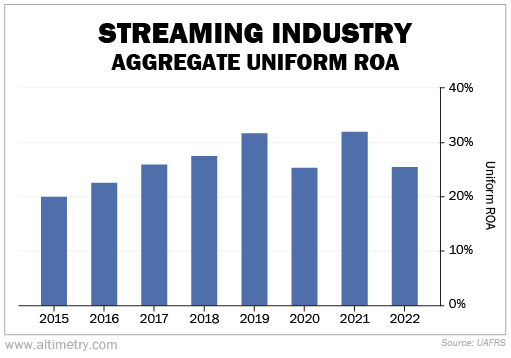 Netflix (NFLX) used to be an incredible value...
Netflix (NFLX) used to be an incredible value...
Folks could subscribe to the streaming service's entire library for just $8 per month. And since Netflix was pretty much the only streamer around, it had every show you could think of.
You could watch NBC's The Office, Warner Bros. Discovery's (WBD) Friends, and your favorite Disney (DIS) movie, all on one platform... for just $8. That was a much better value than cable television. A typical cable subscription could cost 10 times as much. And it usually came with a lot of channels you'd never use.
Netflix helped people save money and cut their cable subscriptions. However, the streaming industry looks quite different today. NBC, Warner Brothers, and Disney all pulled their content and launched their own services.
If you want to access all your favorite shows, you have to buy multiple subscriptions. And worse yet, the streaming services are all raising their prices...
Disney just raised the price on its Disney+ subscription to $14. Netflix, which cost $8 originally, now charges $15 per month for its standard subscription. And Hulu – also owned by Disney – is raising prices to $18 per month in October.
A basket of all the top streaming services now costs more than a monthly cable subscription. They're no longer the money-saving investment they once were. Folks are worried that this could lead to serious backlash for the streaming industry.
So today, we'll look at how this strategy shift is changing the economics of streaming... and reveal the hidden benefit of the market's fear.
 Streaming services are dropping growth in favor of profit...
Streaming services are dropping growth in favor of profit...
And that's a big change from their traditional approach.
As recently as last year, these companies were undercharging customers just so they could grow. When Disney+ launched, it only cost $7 per month. That's how it managed to gain more than 160 million subscribers in its first three years.
That growth came at a cost, though...
Through October 2022, Disney+ cost the company more than $5.6 billion. That's why it has since doubled its subscription costs. Disney is shifting its focus to profit.
It's not the only one. We can see this trend across the entire streaming industry...
Since 2015, the biggest streamers – Netflix, Disney, NBC, Paramount (PARA), and Warner Bros. Discovery – have managed to increase their returns. Uniform return on assets ("ROA") for this group rose from an average of 20% to as high as 32% in 2021.
Take a look...
The industry grappled with growing pains in 2020, when the pandemic began... and then experienced another setback as inflation surged last year. Even so, streaming profitability is clearly heading in the right direction.
And yet, investors think these price hikes are going to kill the industry. We can see this through our Embedded Expectations Analysis ("EEA") framework...
The EEA works a lot like a betting line in a sports bet. We use the current share prices of these streaming giants to calculate what investors expect from future performance... and compare those forecasts with our own.
It tells us how well our "team" (the industry) has to perform to justify the market's "bet" (the current price).
Right now, the market predicts that recent price hikes are going to cut industry returns to just 16% by 2027. That's an even lower Uniform ROA than when these companies were discounting their products just to get subscribers in the door.
Check it out...
These price hikes might slow growth. But they'll likely improve returns. So it doesn't make sense that returns would plunge below 2015 levels from here.
 This transition to a low-growth, high-profitability model might cause some more growing pains...
This transition to a low-growth, high-profitability model might cause some more growing pains...
That doesn't mean the industry is doomed.
Streaming services are pivoting to a more profitable business model. On top of that, tailwinds from the entire communication-services sector are helping these stocks. The industry is experimenting with artificial intelligence as a way to cut costs and boost returns.
Most consumers have moved on from traditional TV. There's little reason to expect a resurgence in cable subscriptions. Subscribers will eventually make peace with higher streaming costs... And streaming services should get even more profitable in the coming years.
It's not often that an entire industry is improving its profitability... while the market totally misses out on the transformation.
We expect the big streaming services to make use of these sector trends and hold up way better than the market expects. And when investors catch on, that could lead to a lot of upside.
Regards,
Joel Litman
August 17, 2023
Editor's note: Joel believes communication-services stocks will be some of the biggest winners of 2023. And in today's roller coaster of a market, you can't afford to ignore those types of tailwinds... because the underlying sector is responsible for more than half of your portfolio's performance.
To help you navigate the current environment, Joel has put together a list of five "winning sector" picks – his favorite stocks in his favorite sectors that will come out on top this year. Plus, he shares one simple move that could lead to 11 times gains... Get the details here.



 Netflix (NFLX) used to be an incredible value...
Netflix (NFLX) used to be an incredible value...



